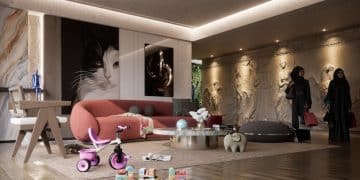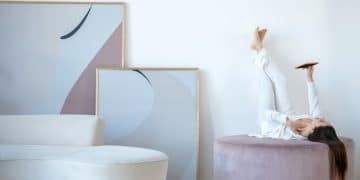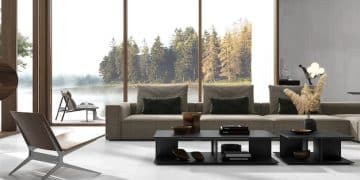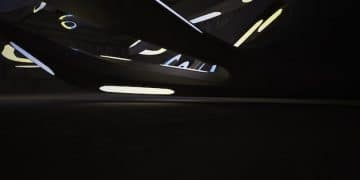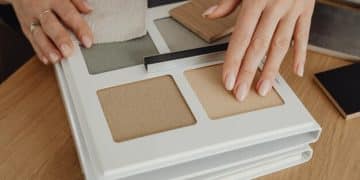2025 Decor Trends: What’s In, What’s out, and Budgeting Tips
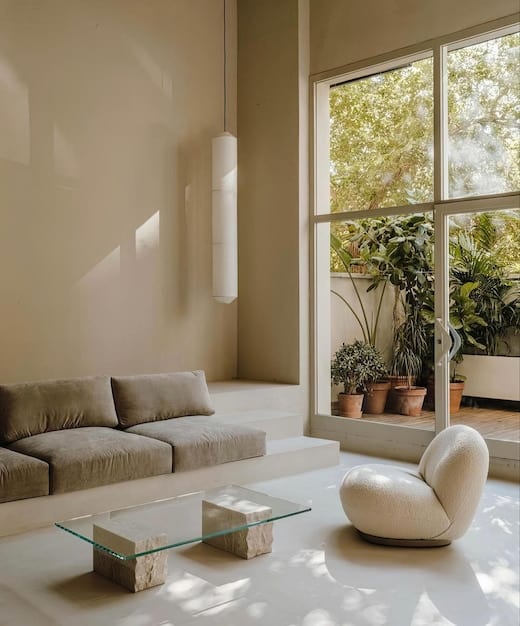
Anúncios
Navigating 2025 Decor Trends: What’s In, What’s Out, and How to Budget Accordingly requires understanding shifts towards sustainability, personalization, and technology integration, demanding strategic planning to update your home affordably and stylishly.
The dawn of a new year always brings with it a fresh wave of design inspiration and evolving aesthetics. For 2025, interior decor is gearing up for a significant metamorphosis, moving beyond fleeting fads to embrace a more thoughtful and sustainable approach. Understanding 2025 Decor Trends: What’s In, What’s Out, and How to Budget Accordingly isn’t just about chasing the latest look; it’s about making informed choices that reflect your lifestyle, values, and financial prudence. This guide aims to prepare you for the coming shifts in home aesthetics, offering actionable insights on how to refresh your living spaces with both style and fiscal responsibility in mind.
The Grand Return of Nature: Biophilic and Sustainable Design
The reconnection with nature is not just a trend; it’s a movement that intensifies in 2025. Biophilic design, which integrates natural elements into the indoor environment, continues its ascendancy, fostering well-being and a sense of calm. This goes hand in hand with a heightened awareness of sustainability, influencing everything from material choices to manufacturing processes. Consumers are increasingly seeking out decor that is not only beautiful but also environmentally conscious and ethically produced.
This shift means a greater emphasis on raw, untreated materials, such as reclaimed wood, natural stone, bamboo, and cork. Plants, both indoor and outdoor, become integral design features, softening harsh lines and improving air quality. Think living walls, large potted trees, and intricate arrangements of various plant species. The goal is to blur the boundaries between indoors and outdoors, creating a harmonious and restorative sanctuary within the home.
Embracing Organic Shapes and Textures
Organic shapes, inspired by nature, are replacing sharp angles and rigid lines. Furniture with gentle curves, fluid contours, and asymmetrical designs will gain prominence. This aesthetic contributes to a softer, more inviting atmosphere, promoting relaxation and comfort. Tactile textures, such as nubby wools, soft linens, raw ceramics, and woven natural fibers, also play a crucial role in enhancing the sensory experience of a space.
* Curved sofas and armchairs
* Sculptural lighting fixtures
* Hand-thrown pottery and ceramics
* Woven baskets and rugs
Authenticity and craftsmanship are highly valued. Pieces that tell a story, whether through their origin, their artisanal creation, or their sustainable footprint, resonate deeply with the conscious consumer. This doesn’t necessarily mean high costs; it often means investing in fewer, higher-quality pieces that are built to last and appreciate over time, reducing future consumption.
The focus on natural elements extends to color palettes as well. Earthy tones—moss greens, terracotta, sandy beiges, and deep blues—will dominate, creating a soothing and grounding backdrop for everyday life. These colors are not just visually appealing; they evoke the tranquility of the natural world, enhancing emotional well-being.
Personalized Sanctuaries: Crafting Unique Living Narratives
Mass-produced, generic interiors are definitely out. In 2025, homes are transforming into personalized sanctuaries, reflecting the unique stories, passions, and journeys of their inhabitants. This trend emphasizes individuality, authenticity, and emotional connection, moving away from prescriptive styles towards a more curated and deeply personal aesthetic. It’s about designing spaces that truly feel like “you,” rather than a showroom.
This shift encourages homeowners to move beyond following trends blindly and instead focus on what brings them joy, comfort, and inspiration. It means thoughtfully selecting pieces that hold sentimental value, whether inherited heirlooms, unique artisan finds, or items collected during travels. The result is a space that feels lived-in, layered, and deeply meaningful, brimming with character and history.
The Art of Curated Collections
Displaying curated collections, rather than clutter, becomes a key design element. This could range from a beautifully arranged display of antique books, a gallery wall showcasing diverse art pieces, or a collection of handmade ceramics. Each item is chosen deliberately, adding depth and narrative to the space. The emphasis is on quality over quantity, and thoughtful arrangement over haphazard display.
* Thoughtful display of sentimental objects
* Eclectic mix of old and new pieces
* Art and decor that reflect personal passions
* Custom-made or bespoke furniture
The rise of the “personal sanctuary” also impacts home layouts. Flexible spaces that can adapt to various activities—from work and relaxation to entertaining and hobbies—are essential. This might involve modular furniture, hidden storage solutions, or multi-functional rooms that can transform with ease. The ultimate goal is to create environments that cater to individual needs and promote a sense of security and belonging.
Investing in personalized design doesn’t mean breaking the bank. It’s often about resourcefulness: reimagining existing pieces, embracing DIY projects, and supporting local artists and artisans. The value comes not from the price tag, but from the story and connection each item brings to the home, creating a space that is truly one-of-a-kind.
Smart Homes, Seamless Living: Tech Integration for Well-being
Technology continues to reshape our lives, and in 2025, it’s becoming even more integrated into interior design, not just for convenience but for enhanced well-being. The focus shifts from visible gadgets to seamless, intuitive systems that anticipate needs and create optimized living environments. This means smart home devices are less about flashy features and more about improving comfort, efficiency, and security without being obtrusive.
Think about lighting systems that adapt to circadian rhythms, adjusting color temperature and brightness throughout the day to support energy and relaxation. Or air purification systems that silently monitor and clean the air quality, ensuring a healthier indoor atmosphere. These technologies are often designed to be invisible, blending into the background of a space while providing significant benefits.
Intuitive Control and Energy Efficiency
Voice-activated assistants are becoming more sophisticated, allowing for complete control over various home functions, from climate to entertainment, with simple commands. This hands-free interaction enhances convenience, reducing friction in daily routines. Moreover, energy efficiency is a major driver, with smart thermostats, automated blinds, and intelligent appliance management becoming standard features in new homes and popular upgrades for existing ones.
* Automated lighting for mood and well-being
* Integrated sound systems for discreet audio
* Smart climate control for optimal comfort
* Security systems blended into architectural design
The integration extends to smart furniture, such as adjustable desks for ergonomic work-from-home setups, or beds that monitor sleep patterns. The key here is that technology serves to enhance the human experience, rather than dominating it. It’s about creating an environment that responds to your needs, promoting a sense of calm and control.
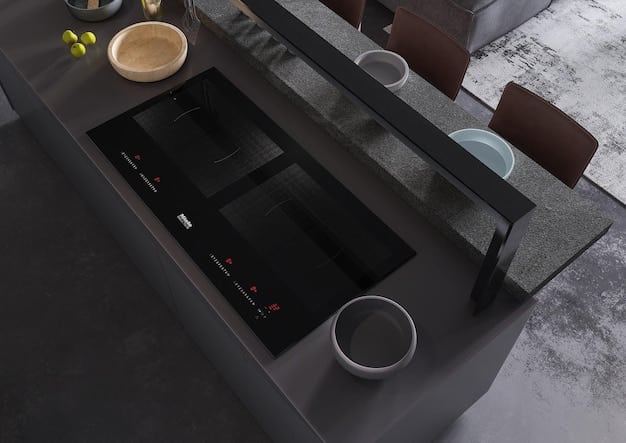
While some advanced smart home systems can be a significant investment, there are many accessible entry points for incorporating technology into your home on a budget. Smart plugs, smart bulbs, and simple voice assistants can start the journey towards a more connected and efficient living space, offering substantial convenience without a hefty price tag.
Color Palettes: Earthy Tones and Subtle Statement Hues
Gone are the days of sterile, all-white interiors or overly saturated, attention-grabbing colors. The 2025 color palette is characterized by a blend of calming, earthy tones and carefully selected subtle statement hues. This shift reflects a desire for tranquility, groundedness, and a connection to the natural world, aligning perfectly with the biophilic design trend.
Neutrals are evolving beyond grays and stark whites. Warm beiges, soft creams, and clay-inspired hues form the foundation, providing a serene and versatile backdrop. These colors create a sense of warmth and inviting comfort, allowing other design elements to shine. They also offer flexibility, making it easier to refresh a space with accent colors and textures without a complete overhaul.
Adding Depth with Muted Accents
While the base palette remains calm, carefully chosen accent colors add depth and personality. These are not loud or overpowering but rather muted and sophisticated. Think dusty rose, deep terracotta, olive green, muted blues, and even rich, chocolate browns. These colors are often drawn from nature, invoking landscapes and natural materials.
* Warm neutrals: cream, beige, soft taupe
* Earthy accents: terracotta, moss green, clay
* Subtle blues and grays for calming effects
* Deep browns and plums for grounding touches
The strategic use of color can transform the mood of a room. For example, a soft olive green can bring a sense of natural tranquility to a bedroom, while a deep terracotta in an entryway can create a welcoming, earthy feel. These colors are often layered through textiles, artwork, and smaller decor pieces, rather than used overwhelmingly on walls.
When budgeting for color updates, consider paint as a highly impactful and relatively inexpensive way to refresh a space. Opting for a rich, warm neutral on walls provides a timeless base. Then, introduce on-trend accent colors through cushions, throws, vases, or artwork. These smaller items are easier and more affordable to replace when tastes evolve, allowing for flexibility within your budget.
What’s Out: Trends Fading Away in 2025
Just as new trends emerge, others inevitably fade, giving way to fresh perspectives and shifting consumer preferences. For 2025, several decor trends that once dominated are now taking a backseat, signifying a move towards more thoughtful, sustainable, and personalized living spaces. Understanding what’s out can help you avoid outdated investments and focus your budget on longevity and genuine style.
The era of overly polished, sterile minimalism, which often lacked personality and warmth, is receding. While clean lines and functionality remain important, the extreme versions that felt cold and unwelcoming are being replaced by designs that embrace texture, comfort, and curated objects. Homes are meant to be lived in, not just admired from afar, and the “less is more” approach is now interpreted with warmth and depth.
High-Gloss Finishes and Fast Furniture
Bright, high-gloss finishes, particularly in kitchens and on furniture, are giving way to matte, textured, and natural surfaces. The desire for authenticity pushes away anything that looks too artificial or overtly manufactured. Similarly, “fast furniture” — cheaply made, disposable items designed for quick replacement — is losing favor. The environmental impact and lack of durability make it a less appealing choice for conscious consumers who prioritize longevity and sustainability.
* Overly polished, sterile aesthetic
* Mass-produced, generic artwork
* Excessively open-plan layouts without defined zones
* Very bright, high-gloss kitchen cabinets
Another trend diminishing in prominence is the overuse of very bold, geometric patterns. While patterns always have a place, the preference is shifting towards more organic, subtle, and tactile patterns, or a more restrained use of bold designs as carefully chosen accents. The goal is to create harmony, not visual overload.
Rooms that serve only one purpose are also becoming less common as flexibility and multi-functionality take precedence. The rigid formality of separate dining rooms or living rooms is being rethought, with homeowners seeking adaptable spaces that can cater to various needs throughout the day. Investing in versatile pieces and creating fluid zones within an open concept is a more contemporary approach.
Budgeting for 2025 Decor Trends: Smart Investments and Savvy Savings
Embracing the latest decor trends doesn’t have to mean breaking the bank. With a strategic approach and a focus on smart investments, you can refresh your home for 2025 in style while staying within your budget. The key is to prioritize quality over quantity, focus on high-impact changes, and master the art of thrifty sourcing.
Start by identifying the elements of your current decor that align with the new trends and those that are definitely “out.” This assessment helps you create a targeted plan, rather than embarking on a full-scale, expensive renovation. Often, small changes can yield significant impact, making a space feel fresh and updated without a huge financial outlay.
Prioritizing Key Investments
Focus your budget on high-impact pieces that offer longevity and can adapt to evolving styles. A well-made sofa in a neutral, textured fabric, for instance, can serve as a foundation for years, allowing you to update the look with
trendy cushions and throws. Investing in timeless art or a statement lighting fixture can also elevate a room without requiring constant replacement.
* Invest in timeless, quality furniture pieces
* Prioritize natural materials for longevity
* Refresh with paint and textiles for low cost
* Explore DIY projects and second-hand markets
When it comes to materials, choosing durable, natural options like linen, wool, solid wood, and natural stone, while potentially a higher upfront cost, often provides better value in the long run due to their resilience and timeless appeal. These materials also align perfectly with the sustainable and biophilic trends of 2025.
For savvier savings, embrace the second-hand market and look for vintage or antique finds. Upcycling and DIY projects can transform existing pieces, giving them a new lease on life and infusing your home with personalized character. Think about painting an old dresser a new earthy tone or re-upholstering an armchair in a textured fabric. These projects not only save money but also contribute to the personalized and sustainable aspects of 2025’s decor. Similarly, a fresh coat of paint in an on-trend color can dramatically change a room’s feel for a relatively small investment.

Remember, successful budgeting for decor isn’t about cutting corners on everything; it’s about making conscious choices. Splurge on a few key, impactful pieces that truly elevate your space and reflect your personal style, then balance these with more affordable, DIY, or second-hand items. This balanced approach ensures your home feels updated and stylish without overstretching your finances.
Integrating Local Artisanship and Customization
The drive towards personalization in 2025 extends significantly to the embrace of local artisanship and custom-made pieces. This trend moves away from globalized, mass-produced goods and instead champions unique items that tell a story, support local economies, and often offer a higher degree of quality and tailored design. Investing in local craftsmanship allows homeowners to create truly distinctive spaces that resonate with their personal values and regional identity.
This means seeking out furniture makers, potters, textile artists, and painters in your community. These artisans not only provide one-of-a-kind pieces, but they often work with sustainable practices and materials, aligning with the broader eco-conscious movement. A custom-made dining table, a hand-thrown vase, or a unique textile artwork adds authentic character that cannot be replicated by factory-made items.
Bespoke Touches and Collaborative Design
The beauty of local artisanship lies in the opportunity for bespoke touches. Homeowners can often collaborate directly with artisans to create pieces that perfectly fit their space, style, and functional needs. This could involve choosing specific wood types for a custom bookshelf, selecting unique glazes for a ceramic collection, or commissioning a piece of art that reflects a personal narrative. This collaborative process makes the resulting decor even more meaningful and deeply personal.
* Support local furniture makers
* Commission unique art pieces
* Explore hand-loomed textiles
* Seek custom pottery and ceramics
Integrating these elements doesn’t necessarily mean higher costs across the board. While a custom piece might be more expensive than a ready-made item from a large retailer, its durability, uniqueness, and the story behind its creation often make it a worthwhile investment. Moreover, by allocating budget strategically – perhaps saving on smaller, easily replaceable items to invest in one significant custom piece – you can achieve a high-impact, personalized look.
This trend also fosters a deeper connection to the community and an appreciation for the skill and dedication involved in traditional crafts. It’s about building a home that is not just aesthetically pleasing but also ethically conscious and reflective of a global shift towards mindful consumption and creative expression.
| Key Decor Shift | Brief Description |
|---|---|
| 🌿 Biophilic Design In | Integrating nature and natural materials for well-being. |
| ✨ Personalized Spaces In | Curating unique items reflecting individual stories and values. |
| 💡 Seamless Tech Integration In | Subtle smart home tech enhancing comfort and efficiency. |
| ❌ Fast Furniture Out | Moving away from disposable, mass-produced items. |
Frequently Asked Questions About 2025 Decor Trends
Biophilic design integrates natural elements like plants, natural light, and organic textures into indoor spaces. For 2025, it’s crucial because it enhances well-being, reduces stress, and creates a calming atmosphere, connecting residents to nature in an increasingly urbanized world. It’s about making homes feel more alive and restorative.
Personalizing on a budget involves curating items with sentimental value, exploring second-hand markets for unique finds, and engaging in DIY projects to update existing pieces. Focus on creating unique displays, mixing old and new, and selecting art and objects that genuinely reflect your passions and experiences. Small, thoughtful additions make a big impact.
In 2025, it’s wise to move away from sterile, overly minimalist aesthetics, high-gloss finishes, and “fast furniture” that lacks durability. Overuse of very bold geometric patterns is also less favored. Focus instead on warmth, texture, natural materials, and items built to last, which align with sustainability and timelessness.
Yes, smart home technologies are evolving to be even more seamless and focused on well-being in 2025. The trend moves towards invisible, intuitive systems that enhance comfort, efficiency, and security without being obtrusive. Think adaptive lighting, smart climate control, and integrated sound systems, all designed to quietly optimize your living environment.
Budgeting for 2025 trends involves prioritizing investments in quality, timeless pieces (like a good sofa) and refreshing with affordable updates such as paint, textiles, and smaller decor items. Explore thrifting, upcycling, and supporting local artisans. Focus on high-impact changes and thoughtful curation rather than complete overhauls, ensuring style and financial prudence.
Conclusion
As we look towards 2025, the world of decor is clearly shifting towards spaces that are not only beautiful but also deeply personal, sustainably conscious, and intelligently integrated with technology. The emphasis is on creating sanctuaries that foster well-being, reflect individual narratives, and respect our planet. By understanding what’s in and what’s out, and by embracing smart budgeting strategies that prioritize quality and thoughtful curation, homeowners can navigate these evolving trends with confidence. Your home in 2025 can truly be a reflection of your evolving values, offering comfort, style, and a meaningful connection to the world around you.
